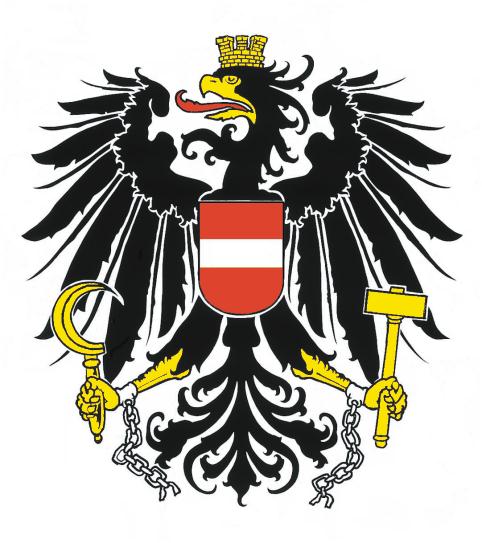National Arms of Austria
Austria heraldry portal
This page is part of the Austria heraldry portal |
Heraldry of the World |
|
Civic heraldry:
|
Other heraldry: |
NATIONAL ARMS OF AUSTRIA
Official blazon
- (de) Das Wappen der Republik Österreich (Bundeswappen) besteht aus einem freischwebenden, einköpfigen, schwarzen, golden gewaffneten und rot bezungten Adler, dessen Brust mit einem roten, von einem silbernen Querbalken durchzogenen Schild belegt ist. Der Adler trägt auf seinem Haupt eine goldene Mauerkrone mit drei sichtbaren Zinnen. Die beiden Fänge umschließt eine gesprengte Eisenkette. Er trägt im rechten Fang eine goldene Sichel mit einwärts gekehrter Schneide, im linken Fang einen goldenen Hammer.
Origin/meaning
Austria became an independent republic after the First World War, on October 16, 1918. Until 1918 it had formed part of the Austro-Hungarian Empire. One of the priorities of the new country was to design National symbols. The official National colours, red-white-red, were officially adopted on October 31, 1918.
On the same day the first proposal for arms was made. It showed a black tower with two crossed hammers and surrounded by wheatears. The tower stood for the cities, the hammers for the labourers and the wheatears for the farmers in the country. The arms were formally used, but many people protested against the poor design and send their own proposals. Finally on May 8, 1919 a coat of arms was officially adopted. These arms were identical to the present arms, with the exception of the chains.
The eagle is the old eagle from the Empire, whereas the shield itself shows the medieval arms of the Duchy of Austria. The mural crown, hammer and sickle are symbols for the liberation of the citizens, labourers and farmers from the Imperial monarchy. The red shield with the silver bend ("Bindenschild") is based on the following legend: The Dukes of Austria of the Babenberg dynasty joined the crusades and fought on the battle of Acco in 1191. According to legend, Duke Leopold was the first to scale the walls of the city, with his white tunic completely covered in blood, except for under his belt. The silver bend on red thus became the arms of Austria.
In 1934 the government removed all the 'new' additions and the arms were reduced to the shield and the Imperial eagle as supporter. Austria was then incorporated into Germany and the arms were abolished.
When Austria regained independence in 1945 the arms from 1919 were restored on May 1st, 1945. The only addition were the chains, symbol of the liberation of the Nazi-regime. Ever since the arms have remained unchanged. On different occasions, however, proposals were made to change the arms and to remove the hammer, chain and sickle, but these were never carried out. The shield itself with the historical arms may also be used as small arms for daily use.
Contact and Support
Partners:
Your logo here ?
Contact us
© 1995-2025, Heraldry of the World, Ralf Hartemink 
Index of the site
Literature: Image taken from http://peter-diem.at/symbols.htm (with permission)












